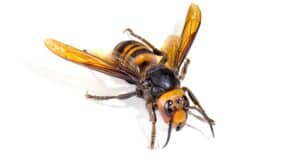While many of us might create pollinator gardens to draw in bees, most of us aren’t so keen on wasps. The stinging, pesky flying insects can be a real problem for folks, especially those with allergies. The wasps in Pennsylvania often sting folks, but the pain levels vary from species to species and may impact your need for medical care.
Let’s look at the types of wasps in Pennsylvania, ranked by the pain of their sting.
About the Schmidt Sting Pain Index

A bald-faced hornet is a species of yellow jacket wasp and not a hornet. Colonies contain 400 to 700 workers. Workers aggressively defend their nest by repeatedly stinging invaders. Their sting is pretty nasty, so you won’t want to mess with a nest if you find one!
©Michael G McKinne/Shutterstock.com
First, let’s clarify: there’s an actual measuring standard for sting pain. Created to scale the pain levels, entomologist Justin O. Schmidt and a team subjected themselves to many insects. The biting or stinging insects were compared by several considerations, including notes on what the stings felt like. This scale is known as the Schmidt Sting Pain Index. And we can thank these courageous individuals for doing the nasty work for us, so we know which wasps to avoid most.
The sting pain levels have been compared to everyday experiences to help us better understand. Some things include electrical shocks, stepping on sharp objects, and more. While we’re only looking at a few items on the list, it actually covers 78 different stings and bites.
Wasps in Pennsylvania — Ranked by Sting Pain Levels
Most of the time, stinging insects aren’t looking for a fight, but rather, are defending themselves when they employ their painful stings. Typically, stinging occurs because of human interference which may be intentional or accidental. The insects don’t know or care, though – they’ve been terrified and so use those painful, tiny daggers to scare you.
Thankfully, stinging insects in Pennsylvania are at the lower end of the pain scale. Of course, sensitivities and allergies may impact the venom’s impact on an individual. But, for the most part, most of the wasps in Pennsylvania offer a painful but not horrifying sting most people can handle without any significant medical intervention.
Sting Pain Level 2 Ratings
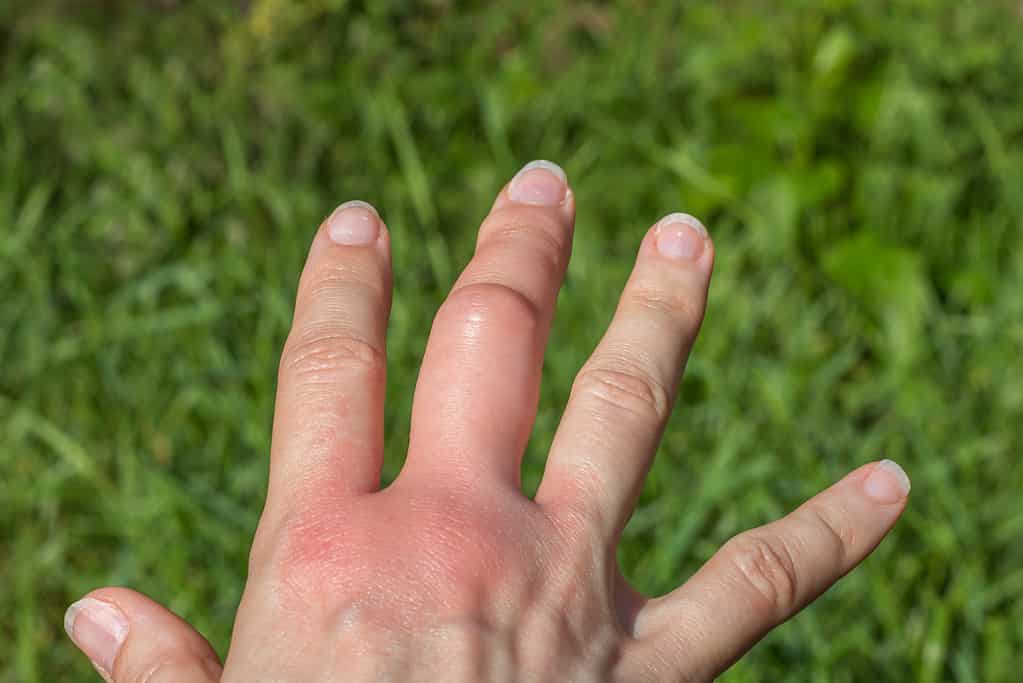
Wasp stings are more commonly painful than dangerous. However, if you see any swelling occur after a sting, you should seek medical attention.
©iStock.com/Inna Kozhina
As an anchoring value, Schmidt set the Western honeybee sting pain level at 2. This makes comparison fairly easy for most folks to consider. However, the exact sensation of the sting varies from insect to insect, with some more feeling like a painful prick and others a bit different.
Ultimately, the scale describes the overall pain level of 2 as a “debilitating migraine” in your finger. Colorful language also may apply, with the description of “a hot smoky, almost irreverent” sting by the yellow jacket, also at a pain level of 2.
Eastern Yellow Jacket
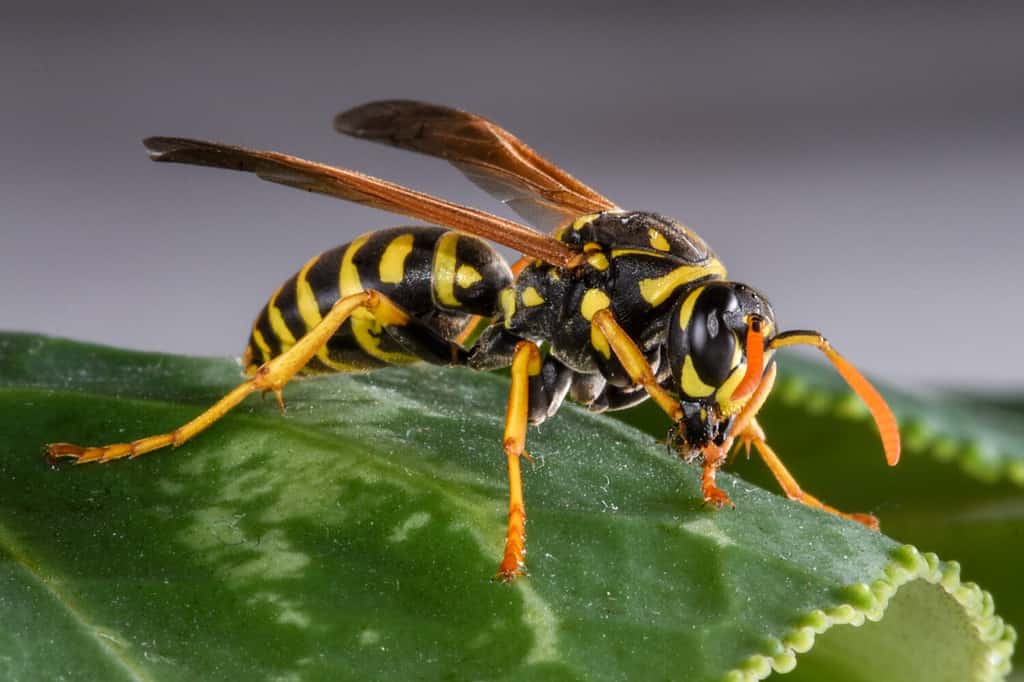
Feeding on a carnivorous diet, Eastern yellow jackets primarily prey on other insects like flies and bees. Their stings are as nasty as the wasp looks, too.
©Randy Runtsch/Shutterstock.com
Ground nesters are black and yellow wasps that make their home in lawns, parks, woodlands, and similar terrains. In most cases, these predatory, social insects are actually helpful against more destructive insects. But the sting of the yellow jacket is pretty painful! And may prove dangerous for those with severe allergies.
For folks not allergic, the stinging pain from Eastern yellow jackets typically lasts for up to 15 minutes and no longer.
Bald-Faced Hornet
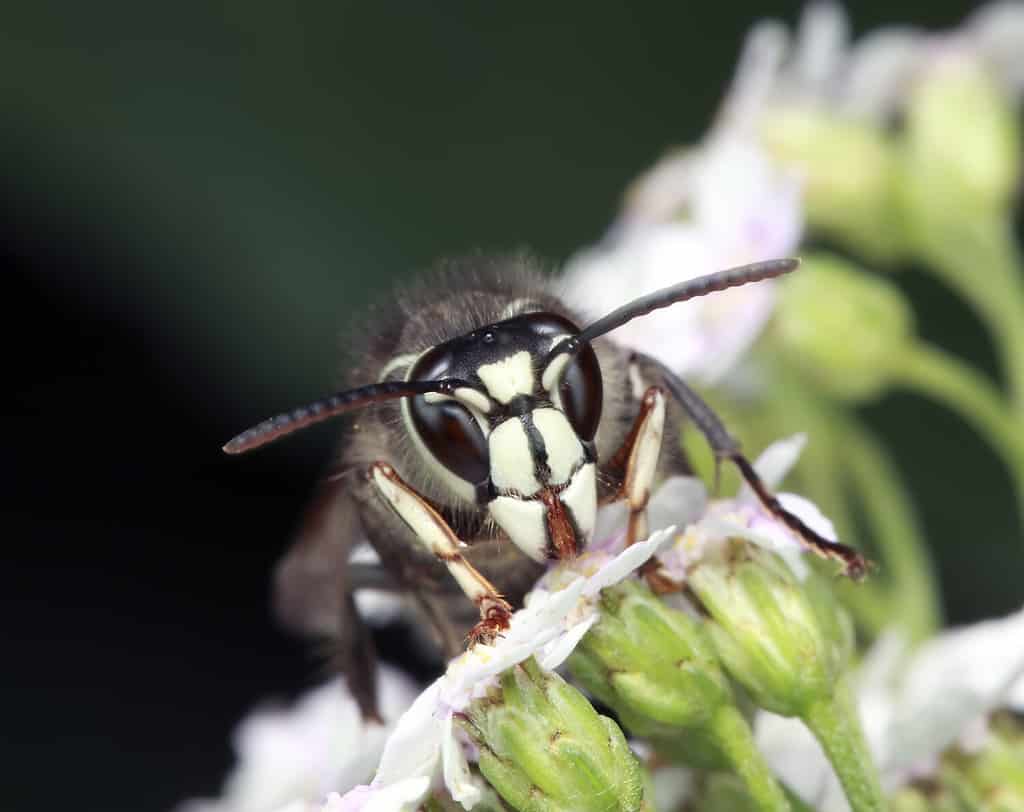
Though wasps and not hornets, Bald-faced hornets deliver some of the most painful stings in Pennsylvania.
©5D2/Shutterstock.com
Technically also in the yellow jacket family, the bald-faced hornet looks similar to Eastern yellow jackets, only with white and black markings. The pain from their venomous sting is similar to that of other yellow jackets, ranking it at level 2. However, bald-faced hornets are much larger, aggressive stinging insects and so many sting several times.
They also may spray venom into the eyes of their victims, making them even more challenging to deal with. In many cases, folks need professional help to get rid of these flying insects.
They make their homes in hollow cavities and shrubs and easily feel threatened.
Schmidt described the pain as similar to that of having your hand smashed in a revolving door. It may throb and ache for up to 15 minutes, though more commonly five. Again, this insect is more dangerous than others for those with severe allergies.
Northern Paper Wasp
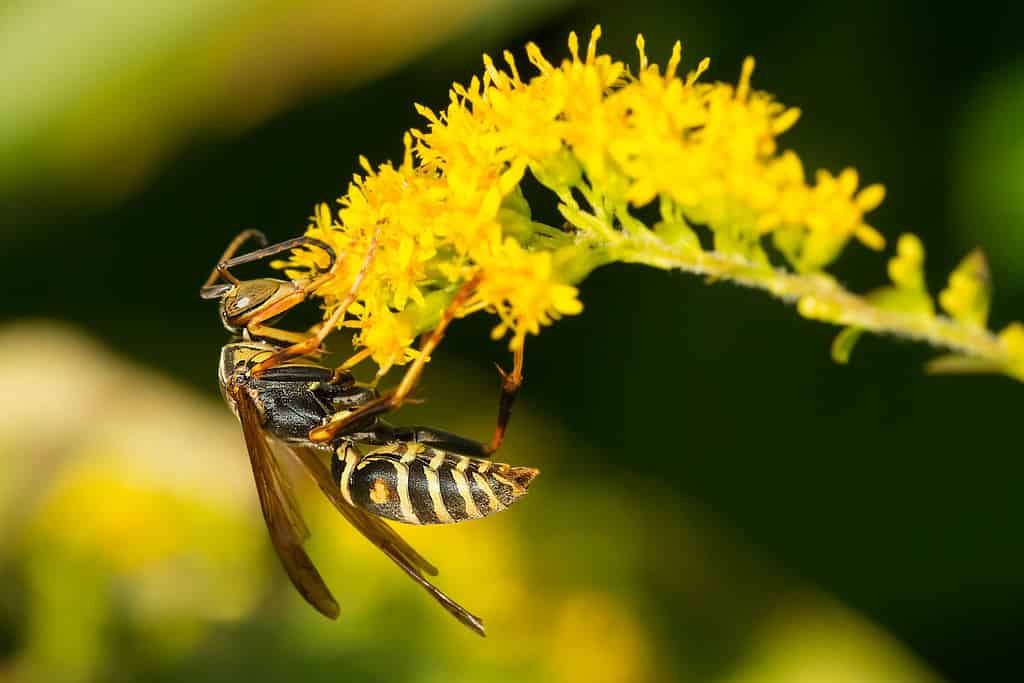
The sting of Northern paper wasp registers at pain level #2 on the Schmidt scale.
©Paul Reeves Photography/Shutterstock.com
With more than 300 species of paper wasps in the world, just 22 of them are found in the United States. Specifically in Pennsylvania, you’ll find both Northern and European paper wasps. These two species register at pain level #2 on the Schmidt scale. They earn their name from the habit of collecting fibers from dead plants and wood and mixing them with saliva. The resulting texture is a gray or brown paper-like material they use to build their nests.
These pests sting multiple times when they feel threatened. Thankfully, the pain fades for most victims after fifteen minutes or less. Seek medical attention immediately, however, if you have any kind of bee or wasp allergy.
Scoliid Wasp

The Scoliid wasp is one of the largest species. Their sting, thankfully, isn’t any worse than a yellow jacket, though. They have surprisingly attractive wings with shiny blue-green iridescence.
©revers/Shutterstock.com
Less well-known but equally painful, the Scoliid wasp bears a large, stout body patterned in bright red, yellow, or white, with black. These wasps are parasitoids of soil-inhabiting scarab beetle larvae. 20 species of the wasp family live in America, with many subspecies. The wasps deliver a powerful sting at around the top of the pain level scale #2.
Great Black Wasp
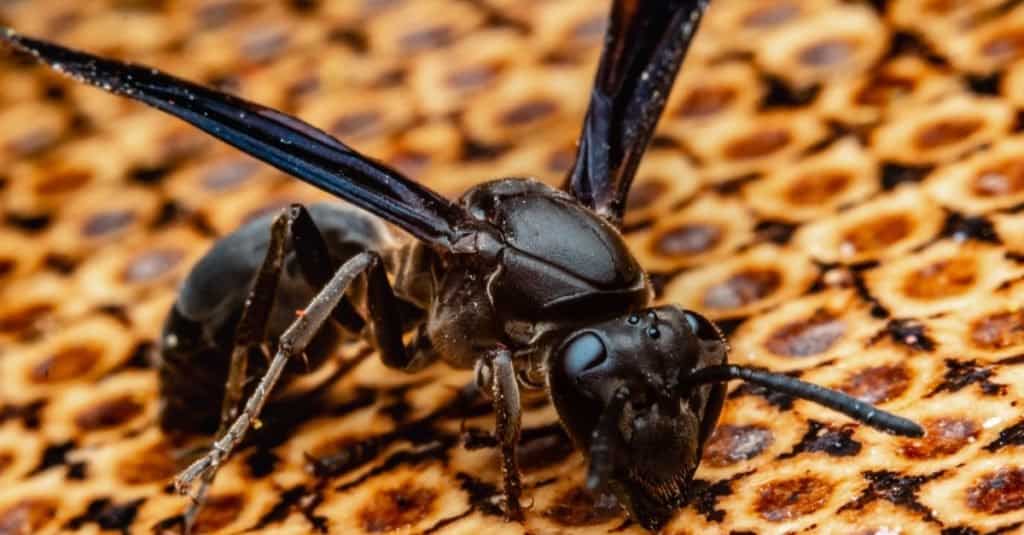
When you see these wasps in Pennsylvania up close, you see why the great black wasp has earned its name.
©JULIO CHINAZZO/Shutterstock.com
Belonging to the thread-waisted wasp family, the great black wasp grows up to 1.5 inches in length – an alarmingly large wasp. Black, smoky wings that shine iridescent blue and matte black bodies help to identify the wasp. They are digging wasps and quickly eat pollen and nectar of flowers all summer long.
These frustrating insects sting their victims three times with paralytic venom. They keep their prey alive for a few days, after dragging them home and pulling them underground. If you see an insect being pulled down, it may well be the victim of one of these nasty bugs.
The pain of a great black wasp hits around the average pain level of #2 on the Schmidt scale.
Tree Wasp
While they bear the common name of tree wasp (or Dolichovespula sylvestris), these flying insects actually build both aerial and underground paper nests. They are one of the many paper wasp species of the world but stand apart from others by their unusual behavior. They inhabit both urban and suburban areas, as well as rural regions.
The wasp is medium-sized, with yellow and black stripes and a black dot on the center of their faces. They may commonly be seen between May and September.
The sting of the tree wasp feels pretty nasty, like other paper wasp stings, ranking right at pain level #2.
Pain Level 1
A significant step down from pain level #2, pain level #1 includes a number of common insect bites and stings you may well relate to. Urban digger bees, Southern fire ants, and most small bees fall within this category.
Schmidt suggested that this pain level is mild enough that there’s almost a pleasant or sensuous sensation, like a nibble on the earlobe just a hint too hard. For those more averse to pain, the light “spark” of the sensation of an arm hair being singed may more suit your expression of this pain level.
Mud Dauber
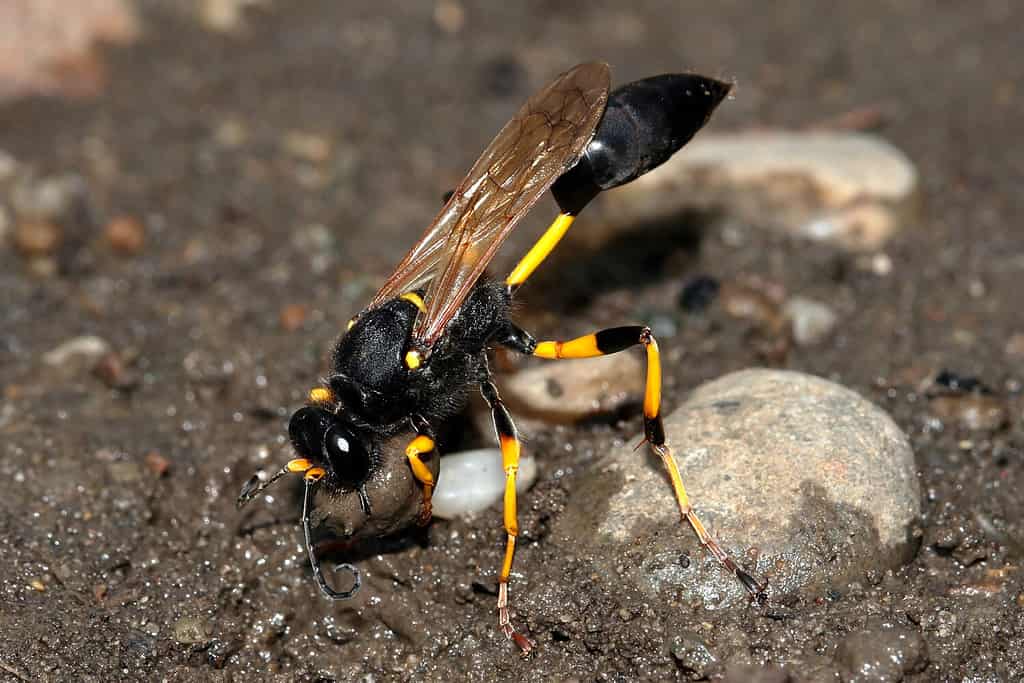
Mud daubers are solitary wasps in Pennsylvania that build their nests out of the mud.
©Geza Farkas/Shutterstock.com
Known for their mud nests, mud daubers tend to frighten folks less so than most wasp species. These insects’ bodies appear thinner than other wasps, with a thin-thread waist, reaching up to 1-inch in length.
These flying bugs do look a bit intimidating, but in reality, they almost never sting. Defending their homes or each other doesn’t strike their minds, either. So, if you see a mud dauber nest in your rafters, you’re probably fine to remove it yourself. Avoid doing so if you have allergies, though, just in case.
Many folks choose to leave the nests, assuming they’re not in dangerous locations or causing damage. Mud daubers help eliminate pests.
Pain Level 0.5
This pain level rates at approximately a minor prick that you may or may not even feel, depending on where you’re stung. Sweat bees and similar insect stings fit in this category and generally don’t bother people.
Eastern Cicada Killer Wasp
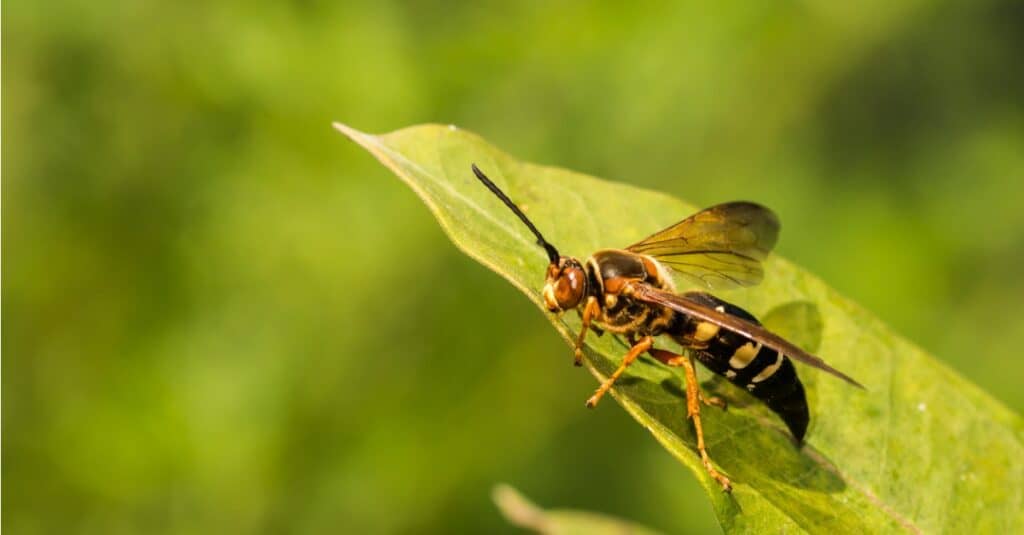
The Eastern Cicada Killer wasp is one of the worst-sounding wasps in Pennsylvania. However, they actually have one of the least painful stings. Unless, of course, you’re a cicada.
©iStock.com/JasonOndreicka
While the name seems a bit frightening, these “killers” find cicadas far more sting-able than humans. They technically belong to the yellow jacket family and measure about 1.5 inches long. Their bodies have yellow and black stripes and their heads are reddish-brown.
They appear in early summer and pollinate all season long. For this reason, and the lack of painful sting, many folks choose to ignore any nests they find. If they feel threatened, they will sting multiple times (females only) but they’re not particularly aggressive.
Thank you for reading! Have some feedback for us? Contact the AZ Animals editorial team.






